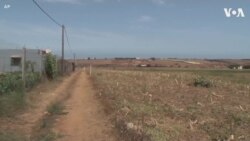At 600 cubic meters of water annually per capita, Morocco is already well below the water scarcity threshold of 1,700 cubic meters per capita per year, according to the World Health Organization.
In the 1960s, water availability was four times higher -- at 2,600 cubic meters.
No longer having access to potable running water, the villagers of Ouled Essi Masseoud rely solely on sporadic supplies in public fountains and from private wells.
"The fountains work just one or two days a week, the wells are starting to dry up and the river next to it is drying up more and more," said Mohamed Sbai as he went to fetch water from neighbors.
The situation is critical, given the village's position in the agricultural province of Settat, near the Oum Errabia River and the Al Massira Dam, Morocco's second largest.
Its reservoir supplies drinking water to several cities, including the three million people who live in Casablanca. But latest official figures show it is now filling at a rate of just five percent.
Al Massira reservoir has been reduced to little more than a pond bordered by kilometres of cracked earth.
Nationally, dams are filling at a rate of only 27 percent, precipitated by the country's worst drought in at least four decades.
The interior ministry ordered local authorities to restrict supplies when necessary, and prohibits using drinking water to irrigate green spaces and golf courses.
Illegal withdrawals from wells, springs or waterways have also been prohibited.
In the longer term, the government plans to build 20 seawater desalination plants by 2030, which should cover a large part of the country's needs.
"We are in crisis management rather than in anticipated risk management," water resources expert Mohamed Jalil told AFP.
He added that it was "difficult to monitor effectively the measures taken by the authorities".
Agronomist Mohamed Srairi said Morocco's Achilles' heel was its agricultural policy "which favors water-consuming fruit trees and industrial agriculture."
More than 80 percent of Morocco's water supply is allocated to agriculture, a key economic sector that accounts for 14 percent of gross domestic product.
A World Bank report noted that cultivated areas under drip irrigation in Morocco have more than tripled.
It said that "modern irrigation technologies may have altered cropping decisions in ways that increased rather than decreased the total quantity of water consumed by the agricultural sector".
.







